
Inchelium is a census-designated place (CDP) in Ferry County, Washington, United States on the Colville Indian Reservation. The population was 431 at the 2020 Census.

Omak is a city located in the foothills of the Okanogan Highlands in north-central Washington, United States. With a population of 4,860 residents as of 2020, distributed over a land area of 3.43 square miles (8.9 km2), Omak is the largest municipality of Okanogan County and the largest municipality in Central Washington north of Wenatchee. The Greater Omak Area of around 8,229 inhabitants as of the 2010 census is the largest urban cluster in the Okanogan Country region, encompassing most of its twin city of Okanogan. The population has increased significantly since the 1910 census, reporting 520 residents just prior to incorporation in 1911.
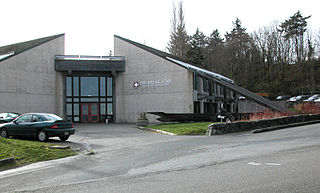
The Daybreak Star Indian Cultural Center is a Native American cultural center in Seattle, Washington, described by its parent organization United Indians of All Tribes as "an urban base for Native Americans in the Seattle area." Located on 20 acres in Seattle's Discovery Park in the Magnolia neighborhood, the center developed from activism by Bernie Whitebear and other Native Americans, who staged a generally successful self-styled "invasion" and occupation of the land in 1970. Most of the former Fort Lawton military base had been declared surplus by the U.S. Department of Defense. "The claim [Whitebear and others made] to Fort Lawton was based on rights under 1865 U.S.-Indian treaties promising reversion of surplus military lands to their original owners."

The Colville Indian Reservation is an Indian reservation in the Northwestern United States, in north central Washington, inhabited and managed by the Confederated Tribes of the Colville Reservation, which are federally recognized.
United Indians of All Tribes is a non-profit foundation that provides social and educational services to Native Americans in the Seattle metropolitan area and aims to promote the well being of the Native American community of the area. The organization is based at the Daybreak Star Cultural Center in Seattle, Washington's Discovery Park. UIATF has an annual budget of approximately $4.5 million as of 2013.
The Confederated Tribes of the Colville Reservation is the federally recognized tribe that controls the Colville Indian Reservation, which is located in northeastern Washington, United States. It is the government for its people.

Franklin D. Roosevelt Lake is the reservoir created in 1941 by the impoundment of the Columbia River by the Grand Coulee Dam in Washington state. It is named for Franklin D. Roosevelt, who was president during the construction of the dam. Covering 125 square miles, it stretches about 150 miles (240 km) from the Canada–US border to Grand Coulee Dam, with over 600 miles (970 km) of shoreline; by surface area it is the largest lake and reservoir in Washington. It is the home of the Lake Roosevelt National Recreation Area.
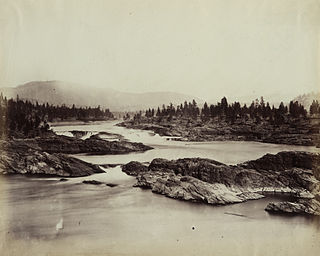
Kettle Falls was an ancient and important salmon fishing site on the upper reaches of the Columbia River, in what is today the U.S. state of Washington, near the Canada–US border. The falls consisted of a series of rapids and cascades where the river passed through quartzite rocks deposited by prehistoric floods on a substrate of Columbia River basalt. The river dropped nearly 50 feet (15 m), and the sound of the falls could be heard for miles away. Kettle Falls was inundated in 1940, as the waters of the reservoir Lake Roosevelt rose behind Grand Coulee Dam, permanently flooding the site.

The Sinixt are a First Nations People. The Sinixt are descended from Indigenous peoples who have lived primarily in what are today known as the West Kootenay region of British Columbia in Canada and the adjacent regions of Eastern Washington in the United States for at least 10,000 years. The Sinixt are of Salishan linguistic extraction, and speak their own dialect (snsəlxcín) of the Colville-Okanagan language.
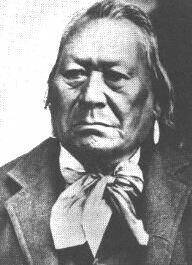
Chief Moses was a Native American chief of the Sinkiuse-Columbia, in what is now Washington state. The territory of his tribe extended approximately from Waterville to White Bluffs, in the Columbia Basin. They were often in the area around Moses Lake. The tribe numbered perhaps a few hundred individuals.
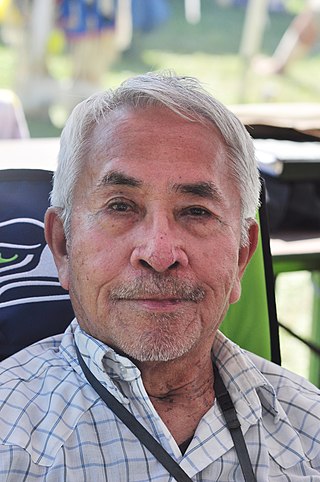
Lawney L. Reyes was an American Sin-Aikst artist, curator, and memoirist, based in Seattle, Washington.
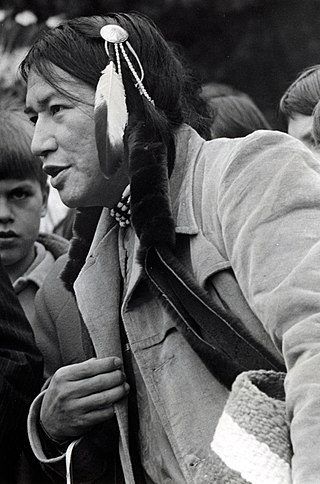
Bernie Whitebear, birth name Bernard Reyes, was an American Indian activist in Seattle, Washington, a co-founder of the Seattle Indian Health Board (SIHB), the United Indians of All Tribes Foundation, and the Daybreak Star Cultural Center, established on 20 acres of land acquired for urban Indians in the city.
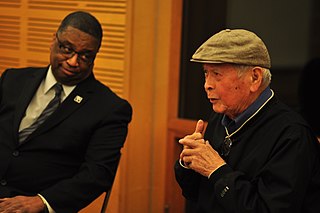
In the politics of Seattle, Washington in the United States, "Gang of Four" refers to Bernie Whitebear, Bob Santos, Roberto Maestas, and Larry Gossett, who founded Seattle's Minority Executive Directors's Coalition.
The Suicide Race, also promoted as the World Famous Suicide Race, is a horse race in the northwest United States in Omak, Washington. It is part of the Omak Stampede, an annual rodeo in early to mid-August.
The Colville people, are a Native American people of the Pacific Northwest. The name Colville comes from association with Fort Colville, named after Andrew Colvile of the Hudson's Bay Company. Earlier, outsiders often called them Scheulpi, Chualpay, or Swhy-ayl-puh; the French traders called them Les Chaudières in reference to Kettle Falls. The neighboring Coeur d'Alene called them Sqhwiyi̱'ɫpmsh and the Spokane knew them as Sxʷyelpetkʷ. Their name in nselxcin, sx̌ʷýʔłpx, refers to "sharp pointed trees".
Joseph Wicks was a judge of the Okanogan County, Washington and Ferry County, Washington Superior Court, where he served for 15 years, and as one of the defense attorneys in Goldmark vs. Canwell.
Joe DeLaCruz was a Native American leader in Washington, U.S., president for 22 years of the Quinault Tribe. He was reputed for his "thorough, in-depth knowledge of probably every Indian tribe in North America." According to Suzan Harjo, "His programs became models for Native Americans everywhere."
Johnpaul Jones is an American architect and landscape architect, partner in Seattle-based architecture firm Jones & Jones Architects and Landscape Architects, best known for innovative habitat immersion method design of zoo exhibits. A person who self-identifies as Native American, he has also executed many projects for various Native American organizations, and was lead design consultant for the Smithsonian Institution's National Museum of the American Indian, completed 2004 in Washington, D.C. He was the first architect ever to receive the National Humanities Medal.
Adeline Mary Sam Fredin (1934–2018) was an American archaeologist, tribal member, Director and Tribal Historic Preservation Officer of the Confederated Tribes of the Colville Reservation. She is best known as one of the first 12 accredited Tribal Heritage Preservation Officers in the United States and for her contributed efforts to the repatriation of Kennewick Man and furthering tribal engagement as an Indian Country leader in Cultural Resource Management. Fredin was a self-taught pioneer in the protection of Native American heritage and rights to the preservation of prehistoric artifacts and human remains. The Washington State Department of Archaeology and Historic Preservation describes Fredin's contributions to the field of archaeology as formative to the relationship between anthropology and tribal histories. Fredin was rumored a force to be reckoned with who maintained relationships with the Secretary of Interior, the White House and the Pentagon, perceived as an attorney of sorts when it came to Indian law.

Pearl Kallappa Warren was an American community leader, based in Seattle. A member of the Makah people, she was the first executive director of the American Indian Women's Service League (AIWSL), leading the group from 1958 to 1969.












